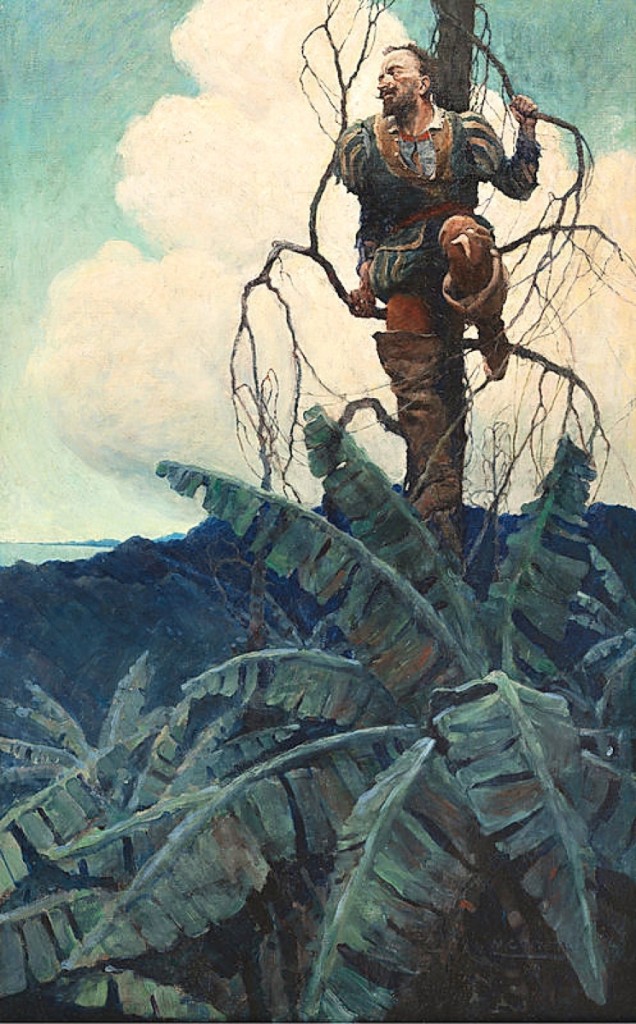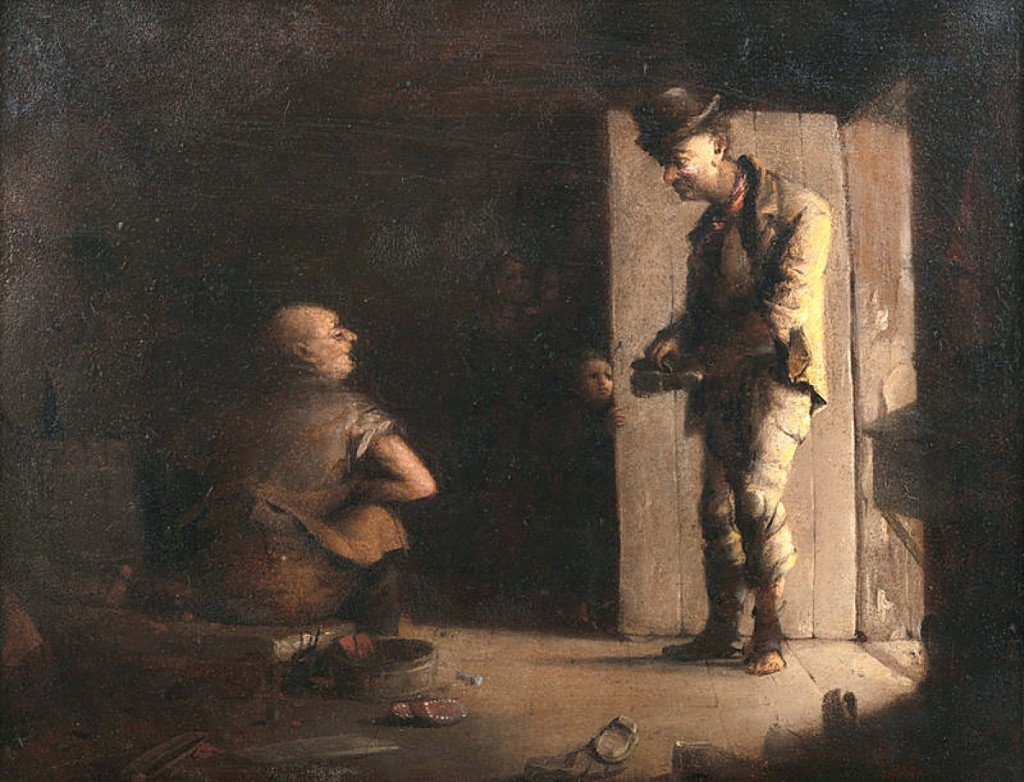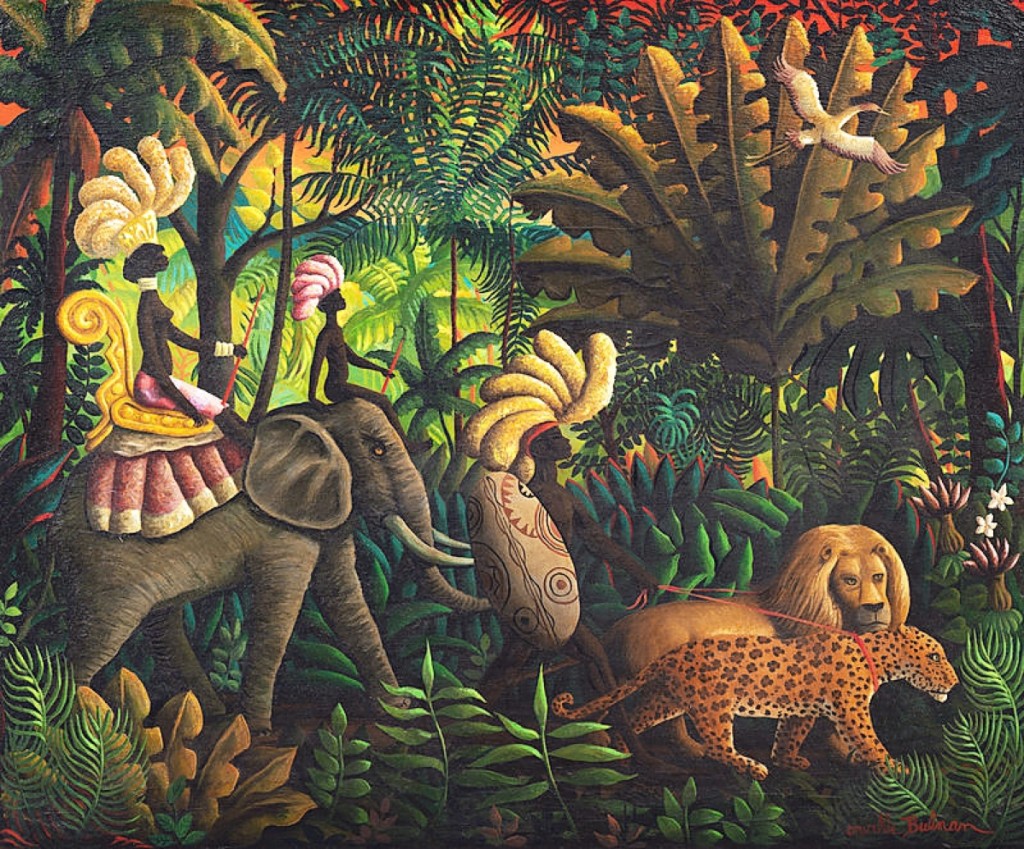
NC Wyeth painted “When Drake Saw for the First Time the Waters of the South Sea,” a 1906 oil on canvas measuring 38 by 24 inches, for The Outing Magazine as a frontispiece illustration for John R. Spears’ article “The Buccaneers, Drake and the Golden Hind.” Letters indicate both he and his teacher, Howard Pyle, found the work to be one of his best at the time. It sold for $275,000.
Review by Greg Smith, Photos Courtesy Hindman
CHICAGO – When 105 lots finally settled at Hindman’s December 13 sale of American and European Art, the clear favorites were the American boys. NC Wyeth ruled the day, David Gilmore Blythe scored a winner and the self-taught Orville Bulman, who adopted a distinctly Haitian style, found favor. That is not to say that the Europeans were far behind, indeed the Frenchman Gustave Loiseau had two impressive highlights alongside Le Pho and Vu Cao Dam.
The auction produced $1,642,625 in total sales.
Two works from Wyeth found the sale’s gold and silver medals. “When Drake Saw for the First Time the Waters of the South Sea,” a 1906 oil on canvas measuring 38 by 24 inches, sold for $275,000. The artist produced the painting for The Outing Magazine in 1906 as a frontispiece illustration for John R. Spears’ article “The Buccaneers, Drake and the Golden Hind.” Contemporaneous letters from Wyeth to his father reveal the artist’s process. In March 1906, he wrote, “I’ve started one of five drawings for Outing and have it on the way to completion. I made one attempt which proved to be unsatisfactory, the second is more successful. Mr Pyle is much pleased with it and claims it to be a big jump ahead. The subject is Sir Francis Drake at the top of a tropical tree gazing for the first time on the South Seas.” Two weeks later, another letter from the artist to his father gushed, “I’ve finished a picture for Outing also, (Sir Francis Drake at the top of a tree…)…I managed to get one of the best illustrations I ever did from it. It pleased me greatly as it was not the result of an inspiration, but of the weaving to-gether of cold hard facts and technical knowledge…”
Wyeth’s other work, “Leaping from Rock to Rock in Sheer Delight,” was painted in 1913 as an illustration for Henry Van Dyke’s story, The Lost Boy, published in the December issue of Harper’s Monthly Magazine. It was one of three images that Wyeth created for that story, which would be published as a stand-alone book a year later. In a letter to his mother Henriette, he remarked that “Harper’s were delighted with my interpretation of Christ…”

Achieving the second highest result for David Gilmore Bylthe was the artist’s “The Cobbler’s Shop,” which sold for $137,500. The work had been exhibited in the artist’s 1981 traveling show “The World of David Gilmour Blythe,” which started at the Smithsonian and ended at the Carnegie Institute, which holds one of the largest collections of the artist’s work. Oil on canvas, 17 by 22 inches.
Rising to $137,500 was David Gilmore Blythe’s “The Cobbler’s Shop,” a painting that over quintupled its high estimate. The oil on canvas of 17 by 22 inches now holds the second highest auction record for Blythe. The painting had been exhibited in a traveling show on the artist, “The World of David Gilmour Blythe,” which made stops at the Smithsonian, the Memorial Art Gallery at the University of Rochester and the Carnegie Institute in Pittsburgh. “The Cobbler’s Shop” is a quintessential genre scene by Blythe, who is regarded for his unvarnished sincerity in depicting the true image of poverty as experienced by both himself and those around him. A small child stands in the shadowed background, having just opened the door for a man in tattered clothing who holds his shoe in his hand, soliciting the cobbler’s services.
All three of the top earners were consigned from the trusts of Barbara V. and William K. Wamelink of Gates Mills, Ohio.
Behind were two works from the Frenchman Gustave Loiseau, the Impressionist artist whose deep friendship with Paul Gaugin gave birth to a body of work that excelled in its interpretation of light and nature. Loiseau’s “Gelée blanche au Vaudreuil (La Route de Louviers),” a 1904 oil on canvas, sold for $118,750. It was consigned from the collection of Kansas state senator Barbara Bollier, whose family it had descended in since 1931. The other Loiseau work apparently came from a different consignor. “Le Quai de L’Oise À Pontoise,” a 1906 oil on canvas, sold for $100,000.

Orville Bulman’s “Entourage de la Reine” is one the artist’s classic jungle scenes. It sold for $83,750. Oil on canvas, 30¼ by 36 inches.
Three works from Orville Bulman, the self-taught Michigan artist whose admiration for Haitian art indelibly altered his own style, got the sale off to a good start. Though he always had a personal practice in art, Bulman’s first dive into the exhibition circuit came in his mid-thirties when he exhibited at New York’s Society of Independent Artists. He began to winter in Palm Beach, Fla., in his forties, which gave him a chance to travel the southern states and gain inspiration for his African American genre scenes. These would bloom into full fruition when in 1952 he visited Haiti for the first time and became enamored with the style of its people and art.
According to Deborah Pollack, “The inspiration of Bulman’s ‘jungle paintings’ of the 1960s-70s was the work of Henri Rousseau, Old Master paintings, along with the lush foliage and tropical scenery of his Manalapan, Fla., home. The islanders in Bulman’s world became princesses, duchesses, kings and queens.” Two jungle paintings led the way, “Entourage de la Reine,” a 1965 oil on canvas of 30¼ by 36 inches, sold for $93,750. His “Très Embarrassant,” an oil on canvas of 25 by 30 inches, brought $50,000. Both create an environment where man and beast coexist without primality, similar to Edward Hicks’ “Peaceable Kingdom” works. The third was a Haitian street scene, “Á ce qu’il paraît,” painted in 1957, which went on to take $15,000. Bulman was a prolifically successful artist, ultimately selling more than 2,000 works in his career into the collections of British duchesses and American presidents.
“We are delighted with the exceptional bidding activity across all sales and to have such a strong ending to 2021,” said Hindman’s director of fine art Joseph Stanfield. “The robust sell-through rates demonstrate the continued strength of the market and the efforts our team takes to organize such carefully thought-out sales.”
All prices include buyer’s premium. For more information, www.hindmanauctions.com.



















